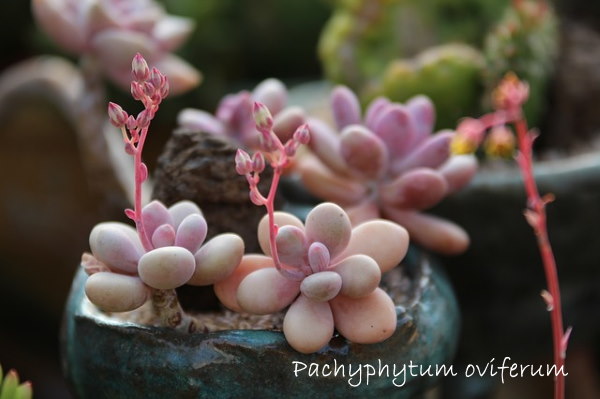Pachyphytum oviferum - Moonstones
Botanical Name: Pachyphytum oviferum
You'll love growing this eye-catching succulent. Commonly called moonstones, those plump, smooth leaves look like polished stones in pretty pastels. Growing in rosettes up to 4 in (10 cm) across, they may be pink, peach, grayish-lavender, light blue or light greenish-blue.
In early spring, flowers appear on tall stems with bell-shaped blooms, ranging from orange to pink or red.
 Pink moonstone adds a splash of color anywhere you grow it. Photo: Manseok
Pink moonstone adds a splash of color anywhere you grow it. Photo: ManseokMoonstones are a succulent in the Crassulaceae family, along with the ever-popular jade plant. This Mexican succulent is just as easy to grow.
Wondering whether to repot? Pachyphytum oviferum is slow-growing and only needs repotted every couple years at most. This succulent stays compact, although it may spread about 12-in (30 cm) wide. Move up to a pot just 1-2 inches (2.5-5 cm) larger; a pot that's too big will hold too much water, which could be the death of this plant. It's a good idea to use a pot with drainage holes.
Something bugging your plant? Mealybugs are the most common pest on succulents. Look for fuzzy, white, cotton-like specks on the stems and leaves. Treat any infestation immediately. If your plant looks limp and wilted and you haven't overwatered it, gently slip the plant out of its pot and check for root mealybugs. They can eventually kill the plant if not treated.
Pachyphytum oviferum Care Tips
Origin: Mexico
Height: Up to 8 in (20 cm)
Light: Partial to full sunlight. Don't have a sunny window? Pachyphytum oviferum thrives under a grow light. You can move the plant outside for the summer, if you want. Just bring it indoors when the temperature drops at night -- this desert native doesn't like the cold.
Water: Water thoroughly, allowing the top half of potting medium to dry out before watering again. The most common care problem is root rot caused by soggy potting medium. Because P. oviferum stores water in its leaves, it is more tolerant of dry potting medium than wet. If you have hopelessly overwatered your plant, repot it immediately in dry potting medium. Are the thick, fleshy leaves deflated or shriveled? If so, the plant needs more water. When watering, take care not to get the leaves wet because they can rot.
Humidity: Average room (around 40% relative humidity). This Mexican succulent can tolerate drier air.
Temperature: This desert succulent likes the same warm temps we do (65-80°F/18-27°C) year-round. If you move your plant outdoors for the warm months, don't worry -- it can take high heat and strong sunlight. Bring it back indoors if it gets cold (50°F/10°C) at night. It won't tolerate frost, which can kill the plant.
Soil: Cactus potting mix provides fast drainage, which this succulent needs.
Fertilizer: Feed monthly in spring and summer with a fertilizer specially made for succulent plants.
Propagation: Take leaf cuttings in spring. Allow the cut ends to dry for a couple days to callous over. Then place the cut ends in lightly moist cactus potting mix. Don't bury them, Pachyphytum oviferum cuttings root easily when they get contact with the potting medium.


